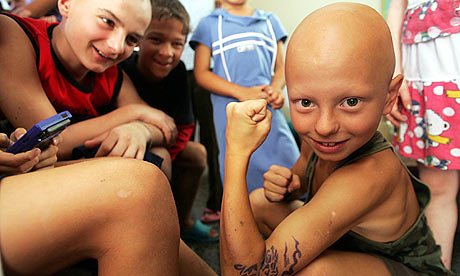Revolutionary care: Castro's doctors give hope to the children of Chernobyl
News from Cuba | Thursday, 2 July 2009

Andres Schipani in Tarara reports for the Guardian on the young victims who continue to receive treatment in Cuba two decades after Ukrainian nuclear disaster
Eleven-year-old Olga enters the beach house in flip-flops, her hair still wet from a dip in the Caribbean. "I really like it here," she says. "The food is great, the beach is awesome. I made some fantastic friends."
A typical child's reaction to a beach holiday, perhaps - only this is no ordinary seaside break. Olga is a Ukrainian "Chernobyl child", in Cuba not for a holiday but to undergo intensive medical treatment with some of the country's best doctors. She goes to school along with 180 other Ukrainian children. "I miss some bits of my home town," she muses. "But I don't ever want to leave."
Olga is one of more than 18,000 Ukrainian children to have been treated over the years at the Tarara facility near the Cuban capital, Havana. The programme was set up in 1990 to treat the victims of the world's most devastating nuclear accident four years earlier.
A steady procession of children with bald heads, skin lesions and other malformations have since benefited from splashing in the clear blue Caribbean waters. Twenty-three years after Chernobyl, the Cuban programme is still going strong. Remarkably, children born years after the disaster still suffer physical consequences of the meltdown that irradiated large parts of Ukraine and Belarus; equally remarkably, despite isolation and economic miasma, Cuba still manages to tend to them.
Olga's freckled face is marbled with pink and brown patches due to depigmentation. Her arms and legs are also affected. She suffers from vitiligo, a skin disease that some believe is caused by a combination of genetic and environmental factors. Both those causes can be attributed to her case: she was born in a small village in the northern Rivne province in Ukraine, near Chernobyl.
The cost of Chernobyl will be met over decades and over generations. There will never be an exact figure of the victims of the catastrophe. For many, the impact is not in their past, but in their future. The damage is not only physical, according to Dr Maria Teresa Oliva, a paediatrician and deputy director of the programme. "[The children] are very much affected by not only medical ailments but also by the psychological effects of their environment and their disease, so they require permanent special care," she says. "Thyroid hyperplasia, vitiligo and alopecia are the most common diseases in these patients." Behind her, Ukrainian and Cuban flags are crossed before two clocks showing the time in Kiev and Havana.
In Tarara the children get treatment based on the seriousness of their illness: sometimes 45 days, sometimes six months - in Olga's case a whole year. Next to her 13-year-old Marina from Kiev is half bald, but slowly recovering her hair. She arrived in March for a third visit to be treated for alopecia. "I love coming here," she says. "I feel much better since I started coming to Cuba. For me there is really no reason to miss Ukraine. The doctors, the teachers, everybody is great."
While some disorders - such as the 30-fold increase in thyroid cancer among Ukrainian children - are directly linked to the Chernobyl accident, it is not known whether some of the other pathologies are caused by radioactive pollution or post-traumatic stress. "But there is a nexus," says Oliva.
Recreation under the tropical sun is as much a part of the cure as the medical treatment. Oliva says: "We have a microclimate here that is highly beneficial." Che Guevara, during his asthma attacks, was taken to Tarara for recovery.
Some of the children are orphans, or come from poor families who cannot afford medical treatment at home. "Ukraine now has a capitalist economy and for most of the families these kinds of treatments are very costly. Here, thanks to the revolution, we can provide everything for free," says Oliva.
Ukrainian authorities have expressed their gratitude to Cuba on several occasions. But though it forms part of Cuba's international revolutionary PR, the difference between this programme and others - such as the exchange of Cuban medical expertise for Venezuelan oil - is that there is no economic gain. The programme even survived Cuba's economic crisis of the early 90s, the so-called "special period" after the fall of the Soviet bloc.
Austerity is still apparent across the island, but the Chernobyl project has survived thanks to an agreement between the two countries: Ukraine covers transportation, while room, board, schooling and medical services are covered by Cuba. Some unofficial estimates put Cuba's expenditure at more than $300m (£180m) in medical costs alone.
"Many people who are unaware of our ideals still wonder what Cuba might be after," Dr Julio Medina, general co-ordinator of the programme, recently told the Cuban newspaper Granma: "It is simple: we do not give what we have in excess; we share all that we have."






